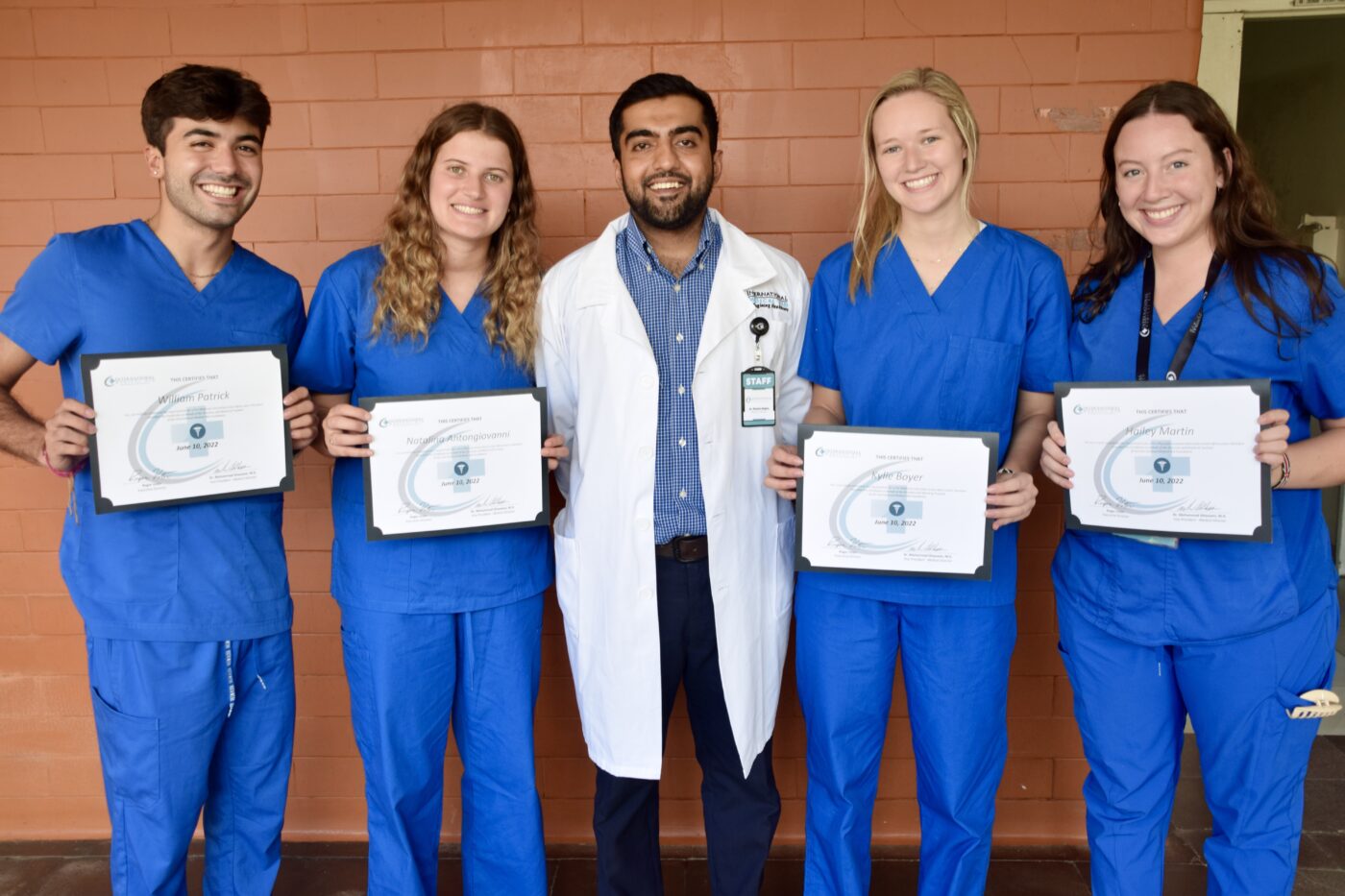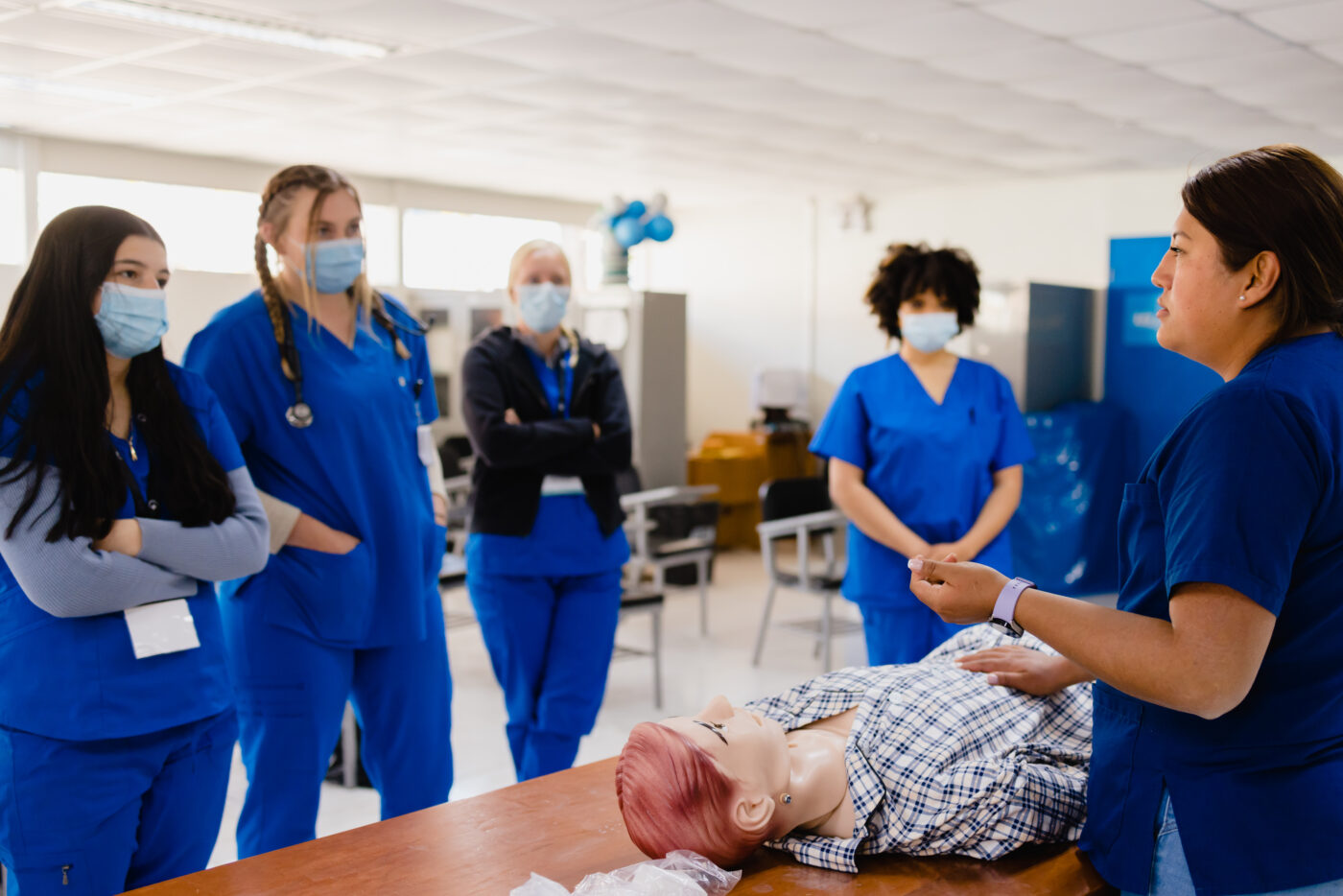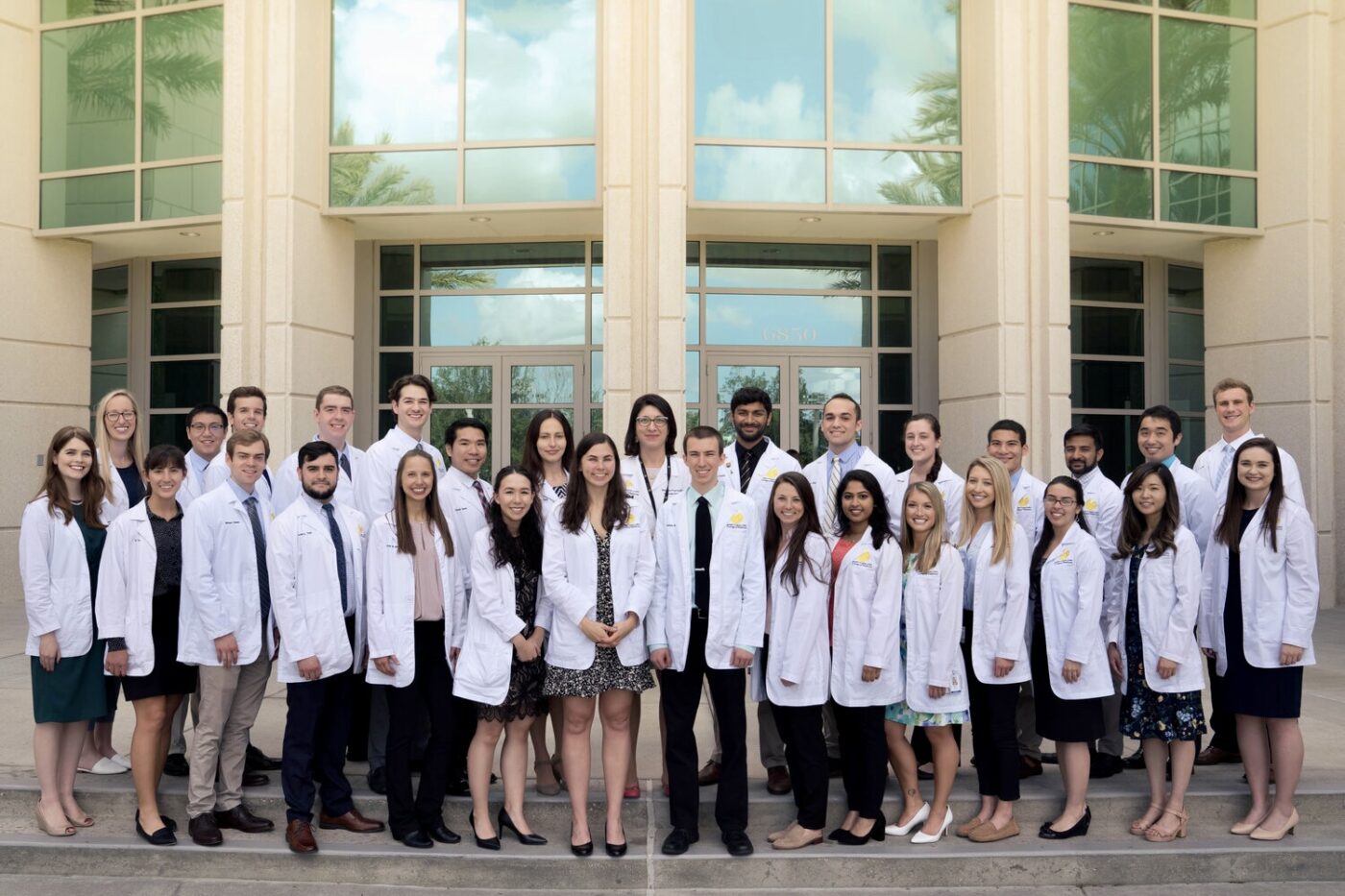Knowing what to wear when shadowing a doctor is about more than just adhering to a dress code. It’s an integral part of your professional presentation. Your attire reflects your understanding and respect for the medical environment, demonstrating your commitment to the opportunity. There’s a quick guide for those already familiar with shadowing.
Quick Guide for What to Wear When Shadowing a Doctor
Business Casual as Foundational Attire
- Recommended attire includes dress pants or khakis, collared shirts, blouses, and closed-toe shoes.
- Avoid casual wear like jeans or shorts.
- Business casual strikes a balance between professional formality and practical comfort.
Comfort and Practicality
- Choose well-fitting clothes and shoes for comfort during long hours of standing or walking.
- Opt for attire that allows easy movement without being overly casual.
Colors and Patterns
- Neutral colors are preferable for their professional look and minimal distraction.
- Bright colors and bold patterns should be used judiciously.
Personal Grooming
- Maintain neat hair, avoid strong fragrances, keep fingernails clean and trimmed.
- Makeup should be minimal and professional.
Lab Coat and Identification
- Wear a lab coat if provided and as instructed.
- Always have identification and any required badges visible.
Cultural Sensitivity
- Be aware of cultural norms in diverse or international settings.
- Adapt attire to reflect local cultural norms where appropriate.
Seasonal Adjustments
- Adjust attire for different weather conditions while maintaining professionalism.
- Consider layering for comfort in varying temperatures.
Accessories and Jewelry
- Choose minimal and understated accessories.
- Avoid excessive jewelry that can distract or interfere with medical equipment.
Footwear
- Wear comfortable, closed-toe shoes.
- Shoes should provide good support and protection in a clinical environment.
The Essence of Shadowing in Medicine
Before we get into extensive detail about what to wear, let’s do a refresher on some of the other elements of shadowing that are just as important as professional attire.
Shadowing in the medical field is an observational experience where a pre-med student or aspirant spends time with a physician or healthcare professional, observing their daily routines and activities. This experience provides invaluable insights into the realities of practicing medicine, the dynamics of patient care, and the overall environment of healthcare facilities.
The primary objective of shadowing is to give aspiring medical professionals a realistic view of what a day in the life of a healthcare provider entails. It allows them to observe patient interactions, understand the workflow in medical settings, and grasp the responsibilities and challenges faced by medical professionals.
Significance of Shadowing for Medical School Applicants
For medical school applicants, shadowing is more than an educational experience; it’s an opportunity to demonstrate their commitment to a medical career. Medical schools often view shadowing experiences as a testament to an applicant’s dedication and understanding of the medical profession. It’s an essential component of a well-rounded medical school application, providing concrete evidence of the applicant’s exposure to and interest in the field of medicine.
Shadowing is predominantly an observational role. The shadowee, typically a pre-med student, does not engage in hands-on patient care or perform medical procedures. Instead, they observe the physician’s interactions, treatments, and decision-making processes. This role is pivotal in helping them understand the nuances of medical practice, including patient communication, ethical considerations, and the application of medical knowledge in real-life scenarios.
Navigating Different Healthcare Environments
Shadowing can occur in various healthcare settings, including hospitals, clinics, and private practices. Each setting offers unique learning opportunities. For instance, shadowing in a hospital might expose a student to a range of specialties and acute medical cases, whereas a private practice might provide a more in-depth view of doctor-patient relationships and the management of chronic illnesses.
Through shadowing experiences, aspiring medical professionals can start building their professional network, gain mentors in the field, and understand the importance of interdisciplinary collaboration in healthcare. It also helps them in refining their career goals and identifying areas of medicine that they are particularly passionate about.
The Role of Medical Schools Admissions Consulting
Medical schools admissions consulting services often emphasize the importance of shadowing experiences in applications. Our consultants guide students on effectively communicating the learning and insights gained from shadowing in their applications and interviews. They also assist in identifying shadowing opportunities that align with the student’s interests and career aspirations.
Pre-Med Shadowing Study Abroad Programs
For students eager to gain a global perspective, pre-med shadowing study abroad programs offer a unique opportunity. Our programs enable students to experience healthcare systems and medical practices in different cultural contexts, further enriching their understanding of global healthcare challenges and practices.
Shadowing Etiquette and Professionalism
Engaging in a shadowing experience requires adherence to certain etiquette and professionalism. This includes maintaining patient confidentiality, exhibiting respectful behavior, and dressing appropriately, as discussed earlier. Being punctual, attentive, and prepared to observe and learn are also crucial aspects of shadowing etiquette.
Keeping a detailed record of shadowing experiences is vital for future applications and reflections. Documenting the hours, settings, and types of medical practices observed, along with any significant learnings or observations, can be helpful when crafting personal statements or preparing for medical school interviews.
To maximize the learning experience, it’s beneficial to engage in reflective observation, ask thoughtful questions at appropriate times, and seek feedback or career advice from the physician being shadowed. Demonstrating curiosity and a keen interest in learning can make the shadowing experience more enriching and rewarding.
Shadowing as a Pre-Medical Student
Pre-medical students often engage in shadowing to confirm their interest in pursuing a medical career. This early exposure helps them in making informed decisions about their future and provides a solid foundation for their medical school journey.
The Impact of Shadowing on Career Choices
Shadowing experiences can profoundly impact a student’s career choices. By observing different medical specialties, students can better understand their own interests and aptitudes, guiding them toward a specific field of medicine.
Shadowing and the Application Process
In the medical school application process, shadowing experiences are often a focal point. Admissions committees look for candidates who have taken the initiative to gain real-world exposure to the medical field. This experience not only enhances the application but also prepares the applicant for the rigors of medical education.
Shadowing as a Stepping Stone in Medicine
Shadowing is an indispensable stepping stone for anyone aspiring to enter the medical field. It provides a realistic preview of the medical profession, helps in making informed career decisions, and plays a crucial role in the medical school application process. For aspiring medical professionals, shadowing is the first true glimpse into the world they are about to enter, shaping their future in profound ways. By embracing shadow
The Importance of Proper Attire
What you choose to wear when you are shadowing a doctor is not just about following a dress code. Your decision is a direct reflection of your professionalism and respect for the medical environment. Appropriate clothing demonstrates your seriousness about the opportunity and your understanding of the norms within a healthcare setting.
Key Considerations for What to Wear When Shadowing a Doctor
Business Casual as Foundational Attire
Business casual attire is typically recommended for shadowing a doctor. This includes items like dress pants or khakis, collared shirts, blouses, and closed-toe shoes. Avoid jeans, shorts, and other casual wear.
When shadowing a doctor, the emphasis on attire leans heavily toward business casual. This preference is both aesthetic and an aspect of the medical profession’s decorum and respect for the patient environment.
Business casual, encompassing dress pants, khakis, collared shirts, and blouses, strikes a balance between professional formality and practical comfort. It’s crucial to avoid casual wear like jeans or shorts that might underplay the seriousness of the healthcare setting.
Comfort and Practicality
Comfort is crucial as you might be standing or walking for extended periods. Opt for comfortable, well-fitting clothes and shoes. Choose attire that allows easy movement without being overly casual or revealing.
The essence of choosing attire for medical shadowing lies in balancing professionalism with comfort. Since shadowing often involves long hours of standing or walking, selecting well-fitting, comfortable clothes and shoes is vital. Consider clothing that offers ease of movement without sacrificing the professional look. For instance, opting for non-restrictive dress pants or skirts can ensure comfort throughout an active day in a clinical setting.
Colors and Patterns
Neutral colors are generally preferable, as they convey professionalism. Avoid overly bright colors or distracting patterns that might be inappropriate in a patient care setting.
The color palette and patterns of your attire can subtly communicate your professionalism. Neutral colors are generally preferred in healthcare settings for their professional look and less distracting nature. While brighter colors and bold patterns aren’t strictly off-limits, they should be chosen judiciously to avoid drawing unnecessary attention or appearing out of place in a patient care environment.
Personal Grooming
Personal grooming is as important as your clothing. Ensure your hair is neat, and avoid strong fragrances. Fingernails should be clean and trimmed, and makeup should be minimal and professional.
Lab Coat and Identification
In some settings, you may be required to wear a lab coat. If provided, wear it as instructed. Always carry identification and any required badges visibly.
Cultural Sensitivity
Be aware of cultural norms, especially in diverse or international settings. What’s appropriate in one country might not be in another. For instance, in Italy, a more stylish approach to business casual is common, reflecting their cultural norms around fashion.
Seasonal Adjustments
Adjust your attire according to the weather while maintaining professionalism. Layering can be effective in different temperatures.
Knowing and respecting cultural norms, especially in diverse or international settings, is crucial. For example, what’s considered appropriate business casual in one country might differ significantly in another. Similarly, adapting your attire to seasonal variations while maintaining professionalism is important. Layering clothing can be an effective strategy to stay comfortable and professional throughout the year.
Accessories and Jewelry
Keep accessories to a minimum. Simple, understated pieces are best. Excessive jewelry can be distracting and may interfere with medical equipment or procedures.
Footwear
Comfortable, closed-toe shoes are a must. They should provide good support and protection in a clinical environment.
Accessories should be chosen with a minimalist approach. Simple, understated items that don’t distract or interfere with medical equipment are ideal. In terms of footwear, the focus should be on closed-toe shoes that offer both comfort and protection, an essential consideration in a clinical environment.
The Role of Medical Schools Admissions Consulting
Medical school admissions consulting can offer specialized advice beyond academic preparation, such as presenting oneself professionally during shadowing experiences. Our medical school admissions consultants can provide personalized recommendations on attire and demeanor that align with the expectations of medical school admissions committees.
Shadowing a physician is a crucial experience for those on the path to a medical career, providing an invaluable perspective on the day-to-day realities of the profession. Each stage of educational development offers different insights and benefits from this experience.
For a comprehensive understanding of the best practices and potential pitfalls, the dos and don’ts of physician shadowing is an essential read. This guide will help you navigate the experience with professionalism and poise, ensuring that you both learn and contribute effectively during your time in the clinical environment.
Pre-medical students can find advice on securing and maximizing shadowing opportunities in the guide shadowing a doctor as a pre-medical student. This resource is invaluable for those looking to deepen their understanding of medicine and strengthen their medical school applications with practical experience.
High school students curious about a medical future can start early by exploring the guide to shadowing a doctor in high school. Early exposure can be pivotal in deciding whether a career in healthcare is the right path, and this guide offers the foundational steps to gaining that initial, informative experience.
These resources collectively offer students at various stages the insights needed to approach doctor shadowing with confidence, providing a structured framework for engaging with this formative experience in the journey to becoming a healthcare professional.

Embracing the Global Perspective in Pre-Med Shadowing Programs
For students in pre-med shadowing study abroad programs, adapting to the dress code and cultural expectations of the host country is an integral part of the learning experience. These programs offer insights into varying healthcare practices, and the attire should reflect both respect for the local culture and adherence to professional standards.
Essential Tips for Shadowing a Doctor
Shadowing a doctor is a critical step for anyone considering a career in medicine. It offers invaluable insights into the daily life of healthcare professionals and provides a realistic glimpse into the medical field. To make the most out of this experience, here are some comprehensive tips:
Understanding the Role of a Shadow
Observation is Key
The primary role of shadowing a doctor is to observe. Pay close attention to the interactions between the doctor and their patients, the doctor’s approach to diagnosis and treatment, and the overall dynamics of the healthcare setting. This observational learning provides a real-world context to the theoretical knowledge gained in classrooms.
Professionalism and Etiquette
Maintain a high level of professionalism throughout your shadowing experience. This includes dressing appropriately, being punctual, and showing respect to both the medical staff and patients. Remember, you are a guest in a professional environment, and your conduct should reflect that.
Active Engagement and Curiosity
While your role is primarily to observe, showing active engagement is important. Prepare questions in advance, and if appropriate, ask them at opportune times. This demonstrates your interest and eagerness to learn.
Learning Through Diversity
Try to shadow doctors in various specialties and healthcare settings. This will give you a broader understanding of the medical field and help you identify areas that particularly interest you.
Maximizing the Learning Experience
Reflect and Take Notes
After each shadowing session, take time to reflect on your experience. Write down what you learned, any interesting cases you observed, and how these experiences align with your expectations of a career in medicine.
Networking and Mentorship
Use this opportunity to build your professional network. Engaging with doctors and other healthcare professionals can open doors for mentorship, advice, and future career opportunities.
Understanding the Healthcare Ecosystem
Pay attention to how the healthcare facility operates. Notice the teamwork among doctors, nurses, and other staff, and understand the importance of each role in patient care. This awareness is crucial for anyone aspiring to work in healthcare.
Patient Interaction and Empathy
Observe how doctors interact with patients. Notice the empathy, communication skills, and bedside manner displayed by medical professionals. These are crucial skills that you will need to develop as a future healthcare provider.
Preparing for Medical School Applications
Documenting Experiences for Applications
Keep a detailed record of your shadowing experiences. Note the hours, the specialties observed, and any significant learnings. This information can be invaluable when crafting your medical school applications and during interviews.
Seeking Guidance and Feedback
Don’t hesitate to seek feedback from the doctors you shadow. Their insights can provide guidance on how to improve and what to focus on as you continue your journey toward a career in medicine.
Balancing Observation with Academics
While shadowing is important, it should complement your academic endeavors. Continue to focus on your coursework and maintain a strong academic record, as this is a critical component of your medical school application.
Respecting Confidentiality
Always maintain patient confidentiality. This is a fundamental aspect of medical ethics and professionalism. What you observe in a clinical setting should remain confidential.
Beyond Shadowing
Exploring Other Aspects of Medicine
In addition to shadowing, consider engaging in other experiences related to healthcare, such as volunteering at clinics, participating in medical research, or joining pre-med clubs. These activities provide a more rounded view of the medical profession.
Adapting to Global Health Perspectives
If possible, engage in international shadowing experiences or programs. These experiences can expose you to different healthcare systems and broaden your understanding of global health challenges.
Personal Development
Use the shadowing experience as a tool for personal growth. Reflect on how these experiences shape your understanding of medicine and your role as a future healthcare provider.
By following these tips and embracing each shadowing opportunity with an open mind and eagerness to learn, you will gain invaluable insights into the medical profession and be well-prepared for the journey ahead in medicine. Remember, shadowing is just one step in a long but rewarding path toward a healthcare career.
Final Thoughts
Dressing appropriately for a shadowing experience is a critical aspect of presenting yourself as a professional and conscientious aspiring medical student. It reflects your respect for the medical profession and your understanding of the environment you’re entering. Taking the time to choose suitable attire and adhering to these guidelines will help ensure a successful and rewarding shadowing experience.
This guide, while extensive, is a starting point. It’s always advisable to seek specific guidance from the medical facility or professional you will shadow, as standards can vary. Remember, your appearance is often the first impression you make, so it’s important to make it count.




